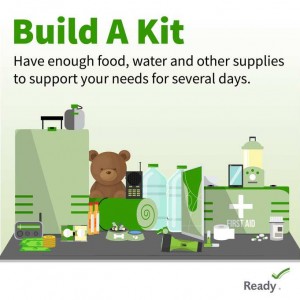 For week two of National Preparedness Month, we’re reminding Arizonans to think about their disaster supplies. This week’s theme is Build a Kit. As the old saying goes, an ounce of prevention is worth a pound of cure. This is true for practicing healthy behaviors like being active, eating healthy, or getting vaccinated, but it’s also relevant for preparedness planning. Taking a little time now to go over what you have and what you might need during a disaster can make all the difference when the time comes.
For week two of National Preparedness Month, we’re reminding Arizonans to think about their disaster supplies. This week’s theme is Build a Kit. As the old saying goes, an ounce of prevention is worth a pound of cure. This is true for practicing healthy behaviors like being active, eating healthy, or getting vaccinated, but it’s also relevant for preparedness planning. Taking a little time now to go over what you have and what you might need during a disaster can make all the difference when the time comes.
Your disaster supply kit should include food, water, and other supplies your household may need in the event of an emergency. Everyone’s kit will be a little different, but some of the basics include:
- Water (one gallon per person per day for at least three days, for drinking and sanitation)
- Food (at least a three-day supply of non-perishable food)
- Manual can opener (for food)
- Flashlight
- First aid kit
- Moist towelettes, garbage bags, and plastic ties (for personal sanitation)
- Extra batteries
- Cellphone with chargers and a backup battery
- Battery-powered or hand crank radio and a NOAA Weather Radio with tone alert
- Whistle (to signal for help)
- Dust mask (to help filter contaminated air)
- Plastic sheeting and duct tape (to shelter in place)
- Wrench or pliers (to turn off utilities)
- Local maps
Take a look at the Ready.gov Emergency Supply Kit Checklist for more ideas on what you might need, like prescription and non-prescription medications.
Additionally, the CDC recommends that people keep additional items on hand to help prevent the spread of COVID-19, influenza, and other viruses. These supplies include masks for people older than age 2, soap, hand sanitizer, and disinfecting wipes.
After you assemble your kit, remember to maintain it regularly to ensure items are safe and ready to use. Consider the following:
- Keep canned food in a cool, dry place.
- Store boxed food in tightly closed plastic or metal containers.
- Replace expired items as needed.
- Re-think your needs every year and update your kit as your needs change.
If you have children in your household, visit the Ready.gov build a kit webpage for kids. There you will find links to games and other resources you can use to get the entire household involved in preparedness.
By working together with our families, friends, and community, we can make sure we have the essential supplies we might need during an emergency. Remember to get on board with National Preparedness Month and take some time this week to build or update your disaster supply kit.









